20 Best Native Plants for Montana
BY KIMBERLY MAGERL | MAY 10TH, 2023 | MONTANA“The Last Best Place,” “Big Sky Country, ” or “The Treasure State,” no matter what you call Montana, it invokes feelings of mystery, excitement, and adventure. It is the fourth largest state by land area in the U.S. and home to grizzly bears, the Continental Divide, rich natural resources, and diverse landscapes. Invite some abundance into your home landscape by filling your yard with some of the best native plants for Montana.
Native plants offer many landscaping benefits, including:
- Native plants support Montana’s diverse ecosystem, providing food and shelter for local wildlife, birds, and insects.
- They are acclimated to the cold, semi-arid climate and four seasons.
- They are low-maintenance, surviving Montana winters, local insects, and disease.
Native plants promote a healthier Montana ecosystem and assist in important conservation efforts. Check out these 20 native plants to help you plan your rich landscape.
In this article, we’ll cover:
- 20 Native Plants for Your Montana Yard
- How to Choose Native Plants for Your Montana Landscape
- FAQ About Native Montana Plants
- Where to Find Native Plants in Montana
20 Native Plants for Your Montana Yard
1. Aster (Asteraceae)
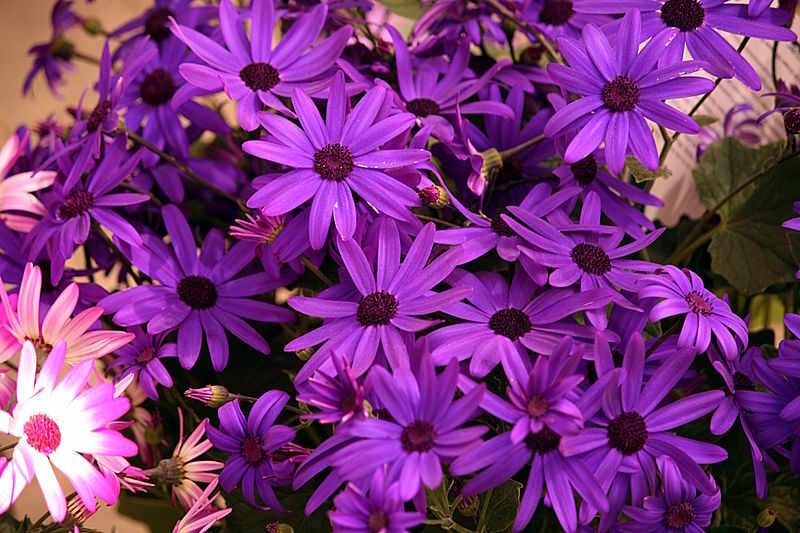
Photo Credit: Hedwig Storch / Wikimedia Commons / CC BY 3.0
Asters are a family of flowering perennials with many species native to Montana. Vibrant, late-summer and early-fall blooms attract pollinating insects, while the dried stalks and leftover seed heads provide food and shelter for songbirds in the winter.
Asters prefer full sun and thrive in the well-drained Scobey, clay loam soils found in the Treasure State. Plant these beautiful blooms in flower beds, containers, or butterfly gardens.
Three common Montana asters include:
- Dotted Blazing Star (Liatris punctata): This aster, also known as dotted gayfeather, grows throughout Montana, producing bright green, narrow leaves that grow along erect, singular stems and lavender bristle-like flowers.
- Hairy Goldenaster (Heterotheca villosa): This showy aster produces bright yellow, slender petals around orange centers and woody stems covered in rough, gray-white hairs. Goldenaster thrives in the dry Montana climate.
- White Prairie Aster (Symphyotrichum falcatum): This aster is a fall-blooming, herbaceous perennial with daisy-like, white blooms with bright yellow centers that thrive in the prairies, fields, and meadows of Big Sky Country.
Growth habit: Herbaceous flower
USDA hardiness zone: 4-8
Mature size: 1-6 feet tall and 1-4 feet wide
Duration: Perennial
Foliage: Deciduous
Sunlight needs: Full sun
Soil preferences: Neutral or acidic, well-drained, loam soil
Water needs: Drought-tolerant; water 1 inch per week; intolerant of standing water
Potential hazards: Non-toxic; edible flowers
2. Beardtongue (Penstemon)
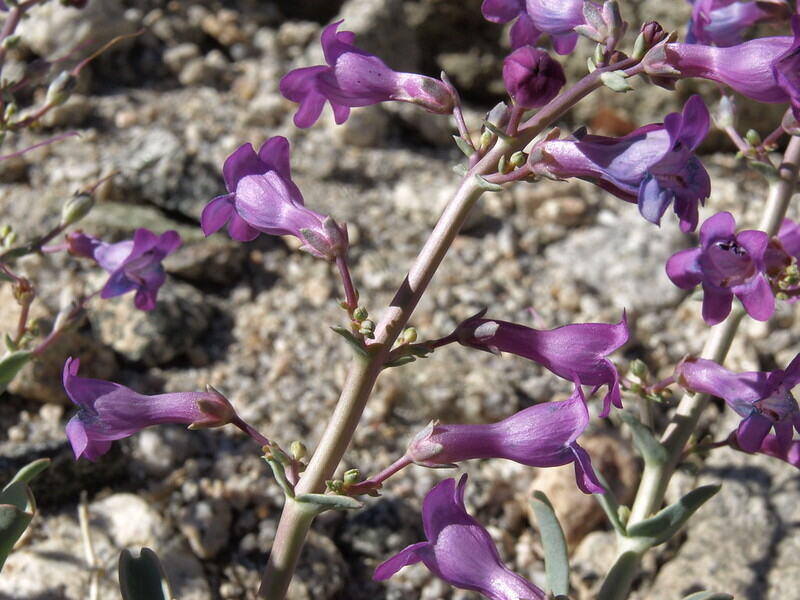
Photo Credit: Jim Morefield / Flickr / CC BY-SA 2.0
Similar to aster, penstemon, known by its common name as beardtongue, is a genus of low-maintenance, long-blooming, colorful, herbaceous wildflowers. They are drought and heat-tolerant and deer and rabbit resistant.
There are 36 species of beardtongue in Montana and many grow across the entire state. Plant these high-impact perennials as part of a pollinator garden to attract hummingbirds, butterflies, and bees. They grow well in raised beds, slopes, and containers.
Three common Montana beardtongues include:
- Fuzzy-tongue Penstemon (Penstemon eriantherus): This showy perennial has a thick taproot, long, bright green stems, and small leaves. It blooms large, lavender flowers with a unique fuzzy, yellow stamen along its lower petals, resembling a tongue in early summer.
- Small-flower Beardtongue (Penstemon procerus): Native to the western half of the state, this herbaceous flower blooms small clusters of vibrant purple and blue flowers along erect, bright green stems.
- Wax-leaf Beardtongue (Penstemon nitidus): This species is shorter than its cousin, growing to 12 inches tall with a spreading habit. Tubular light pink-purple blooms grow along a silvery, blue-green stem among large blue-green leaves.
Growth habit: Herbaceous subshrub
USDA hardiness zone: 3-8
Mature size: 1-6 feet tall and 1-4 feet wide
Duration: Perennial
Foliage: Deciduous to semi-evergreen
Sunlight needs: Full sun to partial shade
Soil preferences: Well-drained, infertile, sand, or gravel soil; avoid enriched soils and clay
Water needs: Drought-tolerant; water 1 inch per week during dry periods
Potential hazards: Non-toxic; no safety hazards
3. Big Sagebrush (Artemisia tridentata)
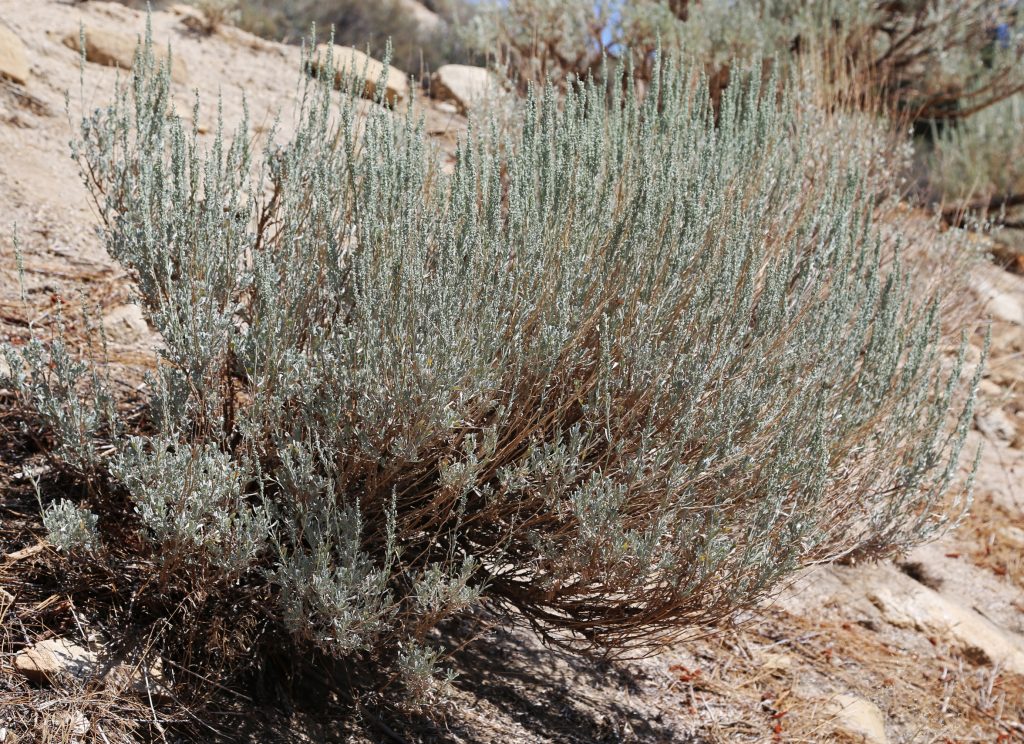
Photo Credit: Dcrjsr / Wikimedia Commons / CC BY-SA 3.0
Big sagebrush, also known as Great Basin sagebrush, is a small to medium evergreen shrub with a twisted growth habit. Specimens typically have a short, branched trunk at the base with velvety, silver leaves that give off a sweet fragrance. It grows across the entire state in subalpine regions, steep open slopes, plains, and valleys.
Big sagebrush is valuable to Montana’s ecosystem, especially in the wild. It is a food and foraging source for deer, moose, antelope, elk, and bighorn sheep and a nesting habitat for songbirds. This hardy perennial makes a great addition to xeriscaping and improves conditions for both your landscape plants and local wildlife. It promotes water filtration thanks to its deep root system and helps maintain snowpack.
Growth habit: Shrub
USDA hardiness zone: 4-9
Mature size: Up to 9 feet tall
Duration: Perennial
Foliage: Evergreen
Sunlight needs: Full sun
Soil preferences: Dry, rocky soils
Water needs: Drought-tolerant; water once per month during dry summers only
Potential hazards: Non-toxic; no safety hazards
4. Bitterroot (Lewisia rediviva)
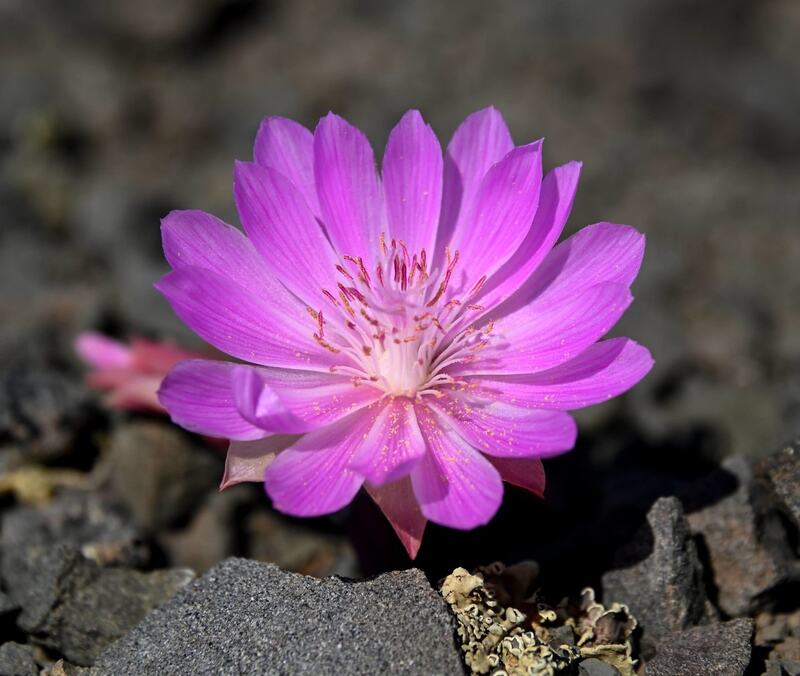
Photo Credit: GlacierNPS / Flickr / Public Domain
Bitterroot, or rock rose, is a member of the purslane family of flowering, herbaceous plants. It is Montana’s state flower. The woody succulent has a taproot system and thrives at mid-elevations in well-drained, rocky soils. Bitterroot grows throughout western and southern Montana along rock ridges and sagebrush slopes.
The ground-hugging perennial produces thick, narrow leaves and enormous pink and white flowers in early spring that last into summer. Grow the ornamental wildflower in rock gardens, wall crevices, and between rocky pathways for a colorful garden escape.
Montana is also home to two other native bitterroot species:
- Alpine Bitterroot (Lewisia pygmaea): Also known as pygmy bitterroot, this flowering succulent is low-growing, producing small pink blooms among dark green leaves. Like its larger cousin, it grows across western Montana in rocky soils and makes a great addition to rock gardens.
- Three-leaf Bitterroot (Lewisia triphylla): This showy succulent produces white flowers with pale yellow centers and bright green leaves. It also thrives in rocky soils across western Montana.
Growth habit: Herbaceous flower
USDA hardiness zone: 3-9
Mature size: Up to 3 inches tall
Duration: Perennial
Foliage: Deciduous
Sunlight needs: Partial shade
Soil preferences: Well-drained, rocky soil
Water needs: Drought-tolerant; water 1 inch per week during the spring growing season
Potential hazards: Non-toxic; edible root
5. Blanketflower (Gaillardia aristata)
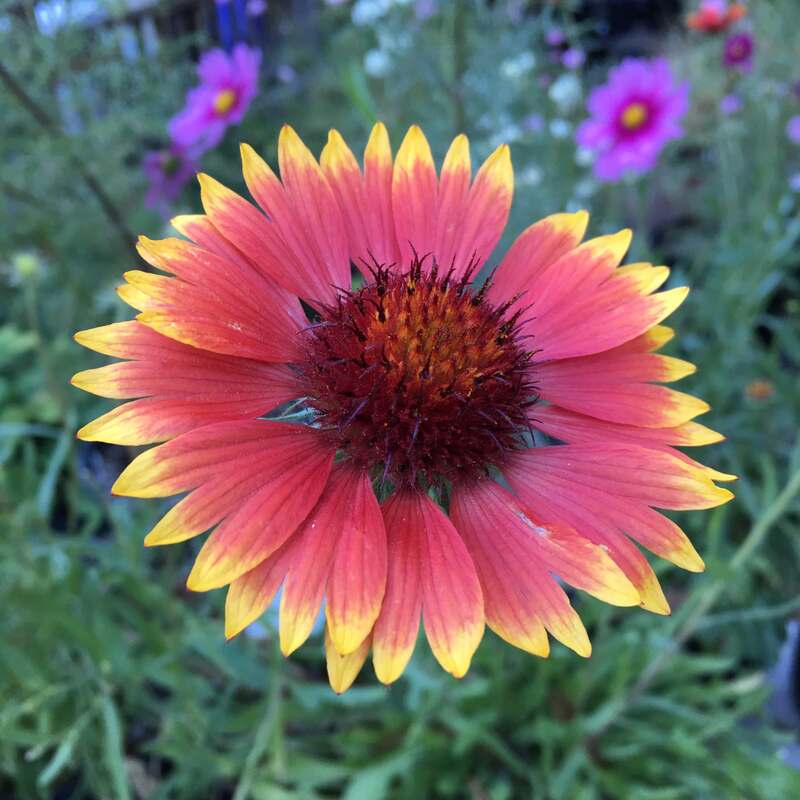
Photo Credit: Macdon / Wikimedia Commons / CC BY-SA 3.0
Blanketflower is another species of aster and a member of the daisy family. Also known as brown-eyed Susan and common blanketflower, this quick-growing perennial produces bright yellow blooms with orange-brown centers atop tall, erect, hairy stems from spring through fall.
This erect clumping plant grows throughout the Treasure State, attracting butterflies and pollinators. It prefers full sun and well-drained soil. It is drought-tolerant and self-sows. This native wildflower makes a great addition to borders, rock gardens, small spaces, containers, and butterfly gardens.
Growth habit: Herbaceous flower
USDA hardiness zone: 3-8
Mature size: Up to 4 feet tall
Duration: Perennial
Foliage: Semi-evergreen
Sunlight needs: Full sun
Soil preferences: Dry, acidic, well-drained, infertile soil
Water needs: Drought-tolerant; water one to two times per week during hot and dry conditions
Potential hazards: Non-toxic; fuzzy hairs irritate skin
6. Buffaloberry (Shepherdia)
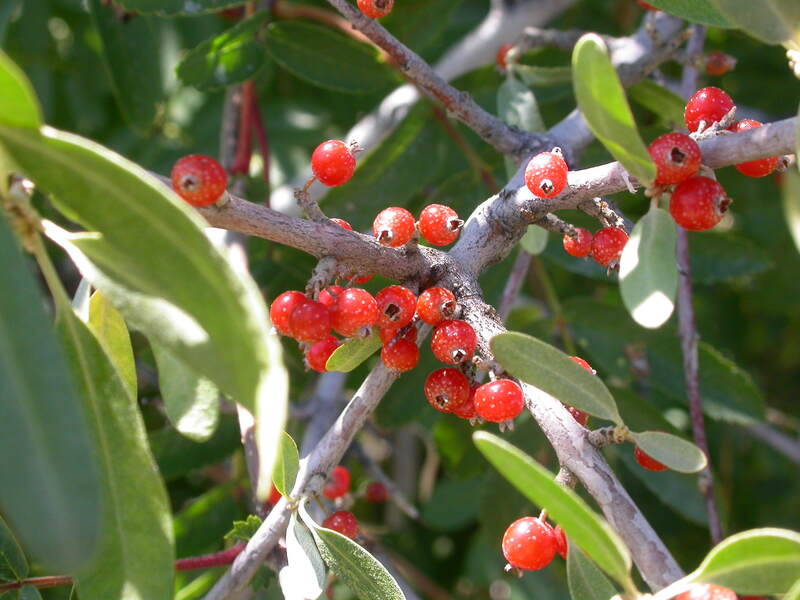
Photo Credit: Matt Lavin / Flickr / CC BY-SA 2.0
Montana is home to two native species of buffaloberry. These loosely branched shrubs have rounded outlines and grow between 4 to 8 feet tall. They have thick, gray-green leaves and produce tiny yellow flowers followed by berry-like fruits in the fall.
These shrubs are extremely cold and drought-tolerant. Low-maintenance buffaloberry attracts native bees. Its fruits are a food source for deer, elk, grizzly and black bears. Grow this low-maintenance shrub as part of xeriscaping, shrub borders, and specimen plantings.
Montana’s native buffaloberry species include:
- Canada Buffaloberry (Shepherdia canadensis): This low-maintenance, multi-stemmed deciduous shrub produces thick, leathery green-gray leaves, inconspicuous yellow flowers, and red, oval-shaped fruits.
- Silver Buffaloberry (Shepherdia argentea): This mounded shrub grows as tall and wide as a small tree, producing silver-gray twigs, gray-toned foliage, inconspicuous yellow flowers, and football-shaped, red-orange berries.
Growth habit: Shrub
USDA hardiness zone: 3-9
Mature size: Up to 10 feet tall; usually shorter
Duration: Perennial
Foliage: Deciduous
Sunlight needs: Full sun, partial shade, full shade
Soil preferences: Adaptable; prefers moist, rocky soils
Water needs: Drought-tolerant; water 1 inch per week
Potential hazards: Non-toxic; edible berries
7. Chokecherry (Prunus virginiana)
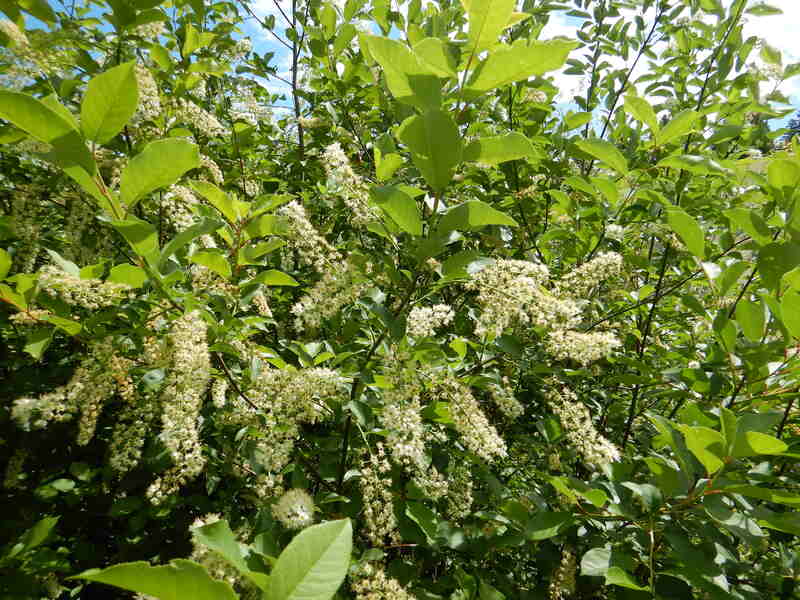
Photo Credit: Matt Lavin / Flickr / CC BY-SA 2.0
Chokecherry is a large deciduous shrub or small tree growing across Montana. Specimens grow up to 30 feet tall, forming dense thickets. Shrubs produce clusters of white flowers flowered by red fruit from August to September. Fruits ripen into a deep purple. They have a bitter taste when raw and immature, but are often made into preserves for a sweet treat.
Chokecherries are beneficial to native pollinators, especially local bee species. They adapt to most soil conditions and have a high shade tolerance. Chokecherry is an important food source for local wildlife. Plant this ornamental shrub as part of a shaded landscape, understory tree, to assist with erosion control, or as part of a living privacy fence.
Growth habit: Tree
USDA hardiness zone: 2-7
Mature size: Up to 30 feet tall
Duration: Perennial
Foliage: Deciduous
Sunlight needs: Sun, partial shade, shade
Soil preferences: Adaptable; dry or moist, rich, limestone, sand, sand-loam, medium-loam, clay-loam, or clay soils
Water needs: Semi drought-tolerant; water 1 inch per week
Potential hazards: Non-toxic; edible, berries are often made into preserves
8. Clover (Dalea)
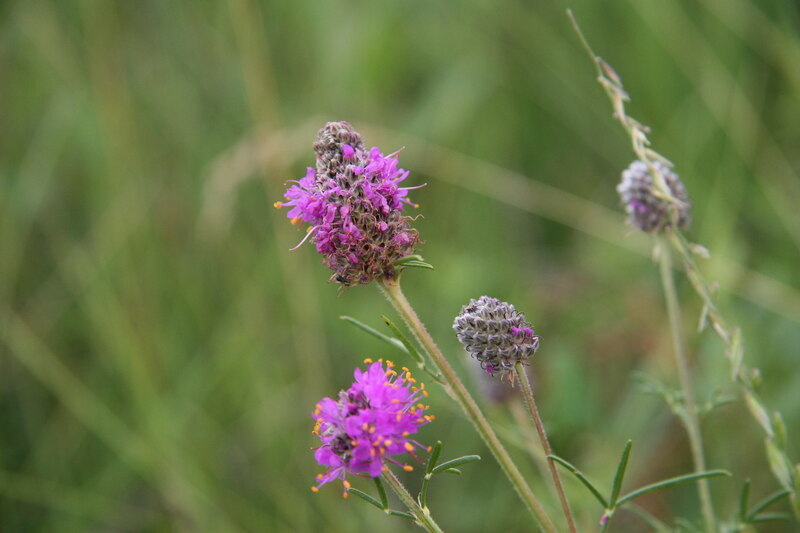
Photo Credit: USFWS Mountain-Prairie / Flickr / CC BY 2.0
Clover is a group of flowering perennials and a member of the pea family. They grow across western and central Montana in open fields, grasslands, and plains. The Treasure State is home to many native and non-native species of clover.
Clovers produce showy blooms among delicate foliage. They have slender, erect stems that reach up to 3 feet tall. Clover grows well mixed with ornamental grasses. Plant these vibrant perennials as part of a pollinator garden, rock garden, or naturalized landscape.
Two popular Montana clovers include:
- Purple Prairie Clover (Dalea purpurea): This low-maintenance wildflower thrives in full sun. It has a deep taproot and is drought tolerant, producing vibrant magenta flowers along a dense green cone atop erect stems.
- White Prairie Clover (Dalea candida): Like its cousin, purple prairie clover, this perennial has a deep taproot and is self-seeding. It produces small white flowers around a dense cone atop bright stems.
Growth habit: Herbaceous flower
USDA hardiness zone: 3-8
Mature size: Up to 3 feet tall
Duration: Perennial
Foliage: Deciduous
Sunlight needs: Full sun
Soil preferences: Adaptable; well-drained soils
Water needs: Drought-tolerant; prefers drip irrigation; rarely requires irrigation outside of natural rainfall
Potential hazards: Non-toxic; edible foliage plant for livestock
9. Coneflower
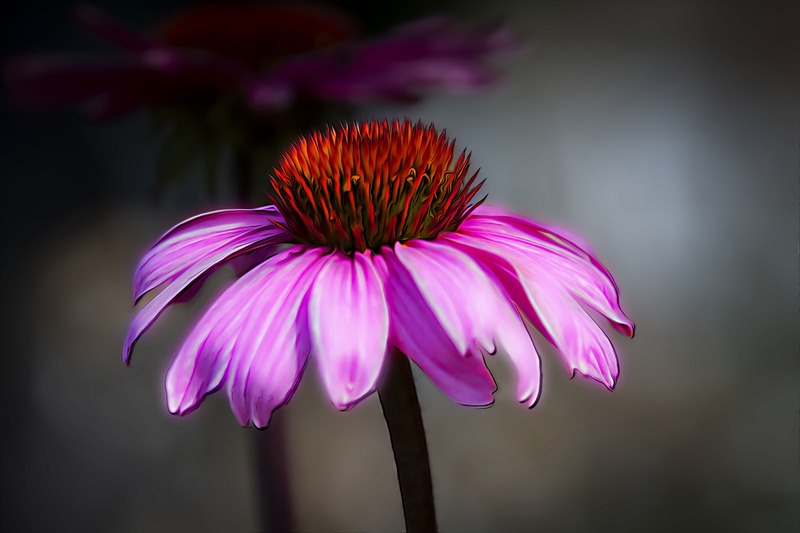
Photo Credit: PublicDomainPictures
Coneflowers are hardy Montana natives in the aster family. These perennials produce showy midsummer blooms. They are deer-resistant and an important member of pollinator gardens, attracting butterflies, bees, and songbirds.
Coneflowers have slender petals growing around a raised, cone center. They naturally self-seed and spread slowly. Species are not aggressive and incredibly low-maintenance. Coneflowers make a great addition to rock gardens, flower beds, containers, and pollinator gardens.
There are three Montana-native coneflowers:
- Cut-leaved Coneflower (Rudbeckia laciniata): This low-maintenance wildflower blooms pale yellow flowers with dark brown cone centers throughout southwestern Montana.
- Prairie Coneflower (Ratibida columnifera): This showy perennial grows across the entire state. It has a deep taproot and produces small, bright yellow petals around a dark brown-black cone.
- Purple Coneflower (Echinacea angustifolia): The hardy plant grows throughout the western half of Montana, producing vibrant purple flowers with orange-brown cone centers atop erect stems.
Growth habit: Herbaceous flower
USDA hardiness zone: 3-9
Mature size: Up to 4 feet tall
Duration: Perennial
Foliage: Deciduous
Sunlight needs: Full sun to partial shade
Soil preferences: Well-drained, rich soil or sand
Water needs: Water 1 inch per week
Potential hazards: Non-toxic; no safety hazards
10. Juniper (Juniperus)

Photo Credit: DJemRose / Wikimedia Commons / CC BY 4.0
Junipers are hardy evergreen plants that thrive across the Treasure State. These versatile landscape plants add color to any landscape year-round. Juniper plant species range from low-growing groundcover bushes to large, towering trees up to 130 feet tall. They are deer-resistant and low-maintenance, requiring virtually no care once established.
Plant junipers to control erosion. They grow well on hills and slopes and as groundcover and border plants. Junipers produce evergreen, needle-like leaves that mature into flattened scales and soften with age. They bloom inconspicuous yellow flowers in the spring that give way to cones and deep blue berries in the fall and winter.
There are three native juniper species in Montana:
- Common Juniper (Juniperus communis): This evergreen is a spreading, low-growing shrub that produces blue-black berries, attracting wildlife across the state.
- Creeping Juniper (Juniperus horizontalis): This berry-producing conifer has a matted growth habit. It grows up to 1 feet tall and 10 feet wide with long, trailing branches.
- Rocky Mountain Juniper (Juniperus scopulorum): Native to the entire state, this evergreen has a rounded, columnar growth habit and produces dark blue, berry-like cones.
Growth habit: Tree, shrub, groundcover
USDA hardiness zone: 2-10
Mature size: 1-130 feet and 1-25 feet wide depending on the species
Duration: Perennial
Foliage: Evergreen
Sunlight needs: Full sun
Soil preferences: Adaptable; prefer slightly acidic, rich, well-drained soil
Water needs: Drought-tolerant; intolerant of standing water; rarely requires irrigation outside of natural rainfall
Potential hazards: Toxic; most berries are poisonous
11. Michaux’s Wormwood (Artemisia michauxiana)
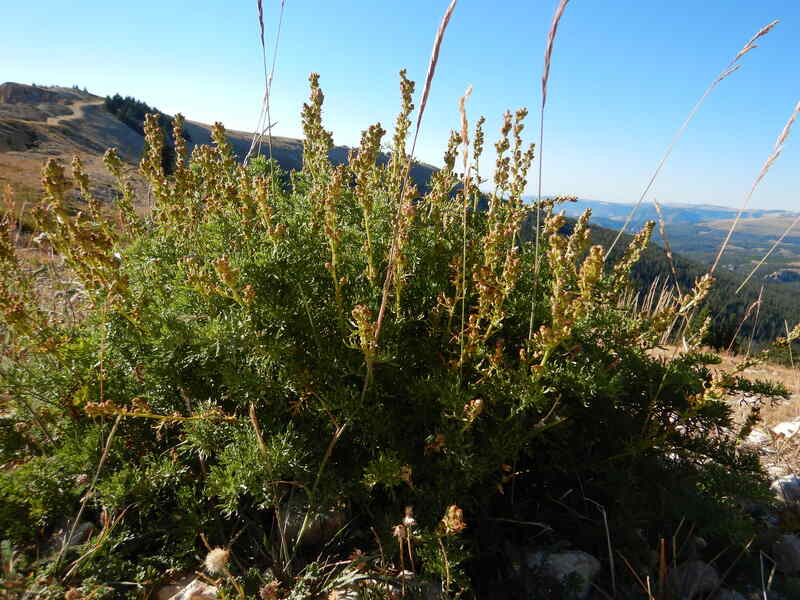
Photo Credit: Matt Lavin / Flickr / CC BY-SA 2.0
Michaux’s wormwood, or lemon sagewort, is another sunflower relative and member of the aster family native to Montana. It grows across the western one-third of the state in fields, outcrops, and alpine woodlands. Michaux’s wormwood is a subshrub with branched stems and a mounding growth habit.
The herbaceous perennial has narrow, segmented, hairy leaves resembling ferns. It produces clusters of small white flowers and seed fruits that attract local wildlife. Plant Michaux’s wormwood in a waterwise landscape, mass planting, or border.
Growth habit: Herbaceous subshrub
USDA hardiness zone: 4-9
Mature size: Up to 40 inches tall
Duration: Perennial
Foliage: Semi-evergreen
Sunlight needs: Full sun; tolerates partial shade
Soil preferences: Adaptable; all soil types except moist, heavy clay
Water needs: Drought-tolerant; requires supplemental irrigation in areas with less than 10 inches of annual rainfall
Potential hazards: Non-toxic; no safety hazards
12. Ponderosa Pine (Pinus ponderosa)
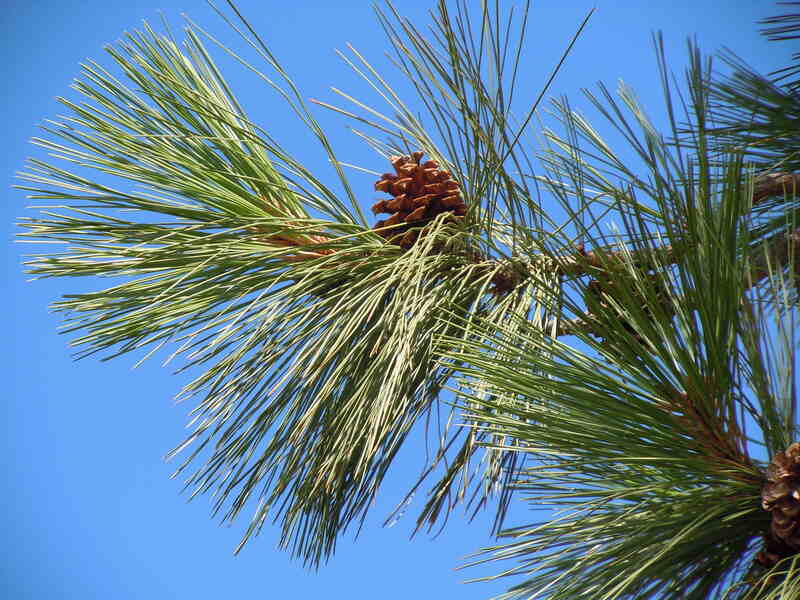
Photo Credit: Matt Lavin / Flickr / CC BY-SA 2.0
Ponderosa pines grow across Big Sky Country in dry forests, rocky exposures, grasslands, plains, and valleys. Like large juniper trees, these specimens grow tall, reaching heights up to 150 feet in home landscapes and 250 feet in the wild. They have short, down-turned branches with dark green needles and reddish-brown, flaky bark.
Ponderosa pines are evergreen conifers producing large cones. They are valuable timber trees and are often used for doors and window frames. They are essential to a healthy Montana ecosystem, offering food and shelter to quail, squirrels, chipmunks, birds, and other wildlife.
Growth habit: Tree
USDA hardiness zone: 3-7
Mature size: Up to 150 feet in home landscapes and 250 feet tall in the wild
Duration: Perennial
Foliage: Evergreen
Sunlight needs: Full sun, partial shade, shade
Soil preferences: Dry or moist, acidic, deep, sand, gravel, or clay loam soils
Water needs: Drought-tolerant; does not require additional water outside of natural rainfall
Potential hazards: Toxic; poisonous needles and bark
13. Pussytoes (Antennaria)
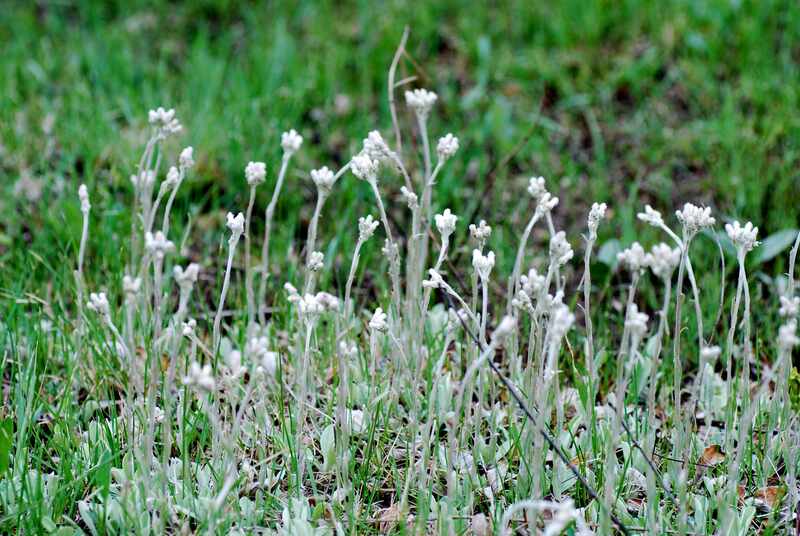
Photo Credit: Joshua Mayer / Flickr / CC BY-SA 2.0
Pussytoes are flowering members of the aster family. Commonly known as catsfoot or everlasting, these perennial plants grow across Montana, attracting butterflies and pollinators. They are a host plant for butterflies and moths and make a great deer-resistant addition to any landscape. Plant pussytoes as ground cover and in flower beds or containers.
Three popular pussytoes specimens in Montana include:
- Howell’s Pussytoes (Antennaria howellii): This creeping groundcover has erect stems and spatula-shaped leaves. It blooms small, white, fuzzy flowers in a fan shape during summer.
- Littleleaf Pussytoes (Antennaria microphylla): This herbaceous perennial forms loose mats and blooms small yellow flowers atop leafy stems.
- Rosy Pussytoes (Antennaria rosea): This low-growing specimen has a spreading and matted growth habit that makes an excellent four-season groundcover. Pink and white,, lobed flowers resembling a cat’s toes bloom through summer.
Growth habit: Herbaceous flower and groundcover
USDA hardiness zone: 3-7
Mature size: Up to 1 foot tall
Duration: Perennial
Foliage: Semi-evergreen to evergreen
Sunlight needs: Full sun
Soil preferences: Adaptable; dry soils; avoid standing water
Water needs: Drought-tolerant; water 1 inch per week during dry periods; allow the soil to dry out between waterings
Potential hazards: Toxic; poisonous if consumed in large quantities
14. Redosier Dogwood (Cornus sericea)
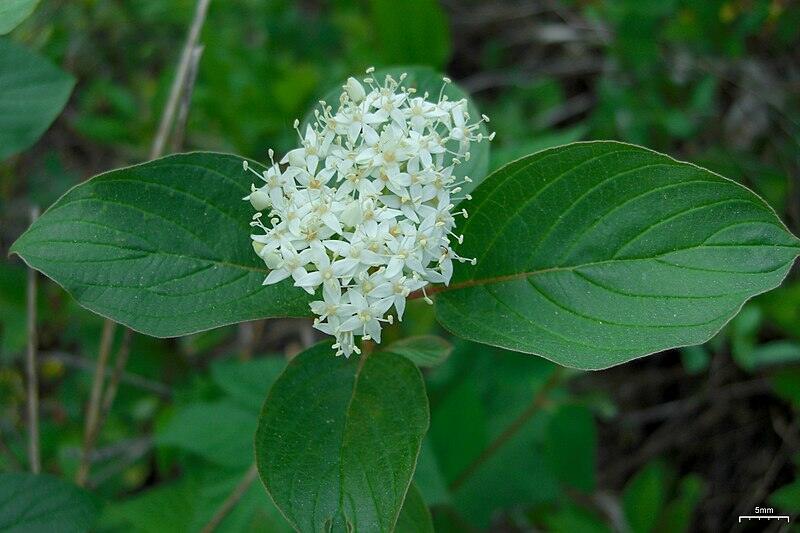
Photo Credit: Jason Hollinger / Wikimedia Commons / CC BY 2.0
Redosier dogwood is a spreading shrub with a loose growth habit and attractive red twigs. It reaches heights up to 12 feet tall, blooming clusters of white flowers that give way to umbrella-shaped white berries from May through October. Redosier dogwood keeps its leaves through fall, which turn shades of red, orange, yellow, and burgundy.
The attractive shrub provides many ecological benefits to Montana’s landscapes. Preferring partial sun, redosier dogwood makes a great addition to wet areas, river banks, lake and pond shores, and wooded or open landscapes. It is the larval host for the Northern Spring Azure butterfly and attracts waterfowl, marshbirds, shorebirds, and large and small mammals such as deer and squirrels.
Growth habit: Shrub
USDA hardiness zone: 2-7
Mature size: Up to 12 feet tall
Duration: Perennial
Foliage: Deciduous
Sunlight needs: Partial Shade
Soil preferences: Adaptable; moist, well-drained soils
Water needs: Does not require additional water outside of natural rainfall unless dry weather persists for a week or more
Potential hazards: Non-toxic; no safety hazards
15. Rocky Mountain Maple (Acer glabrum)
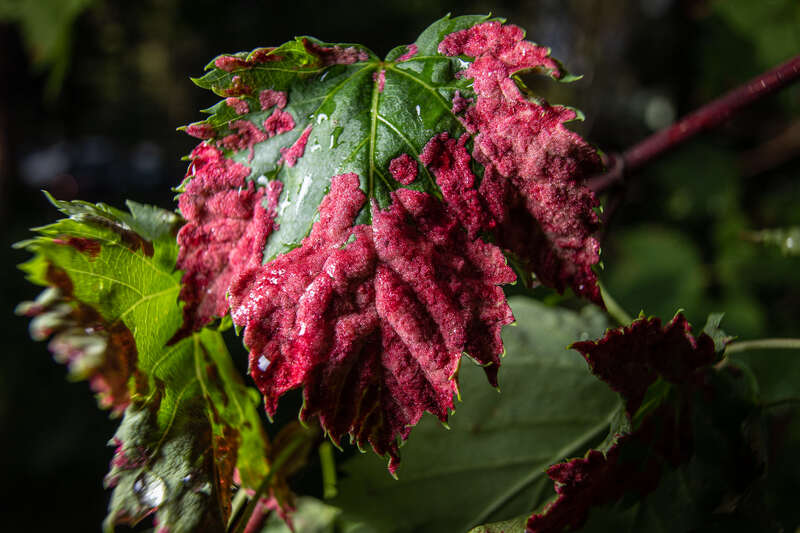
Photo Credit: GlacierNPS / Flickr / Public Domain
Rocky Mountain maple is a small, multi-stemmed tree. It is one of two native Montana maples, growing across the western two-thirds of the state in subalpine coniferous and riparian forests, avalanche slopes, and valleys. Rocky Mountain maple is not a showy tree, but it makes up for it with fragrance. It blooms fragrant, inconspicuous flowers in early spring.
The maple specimen has shiny green leaves that turn yellow and orange every fall and smooth, gray bark with attractive red twigs. Every winter, it drops winged seeds, providing visual interest and a valuable food source for local wildlife. This tree improves wildlife habits and makes a great ornamental addition to a landscape. It is often used as an understory specimen alongside ponderosa pines or to stabilize slopes, shorelines, and banks.
Growth habit: Tree
USDA hardiness zone: 4-8
Mature size: Up to 30 feet tall
Duration: Perennial
Foliage: Deciduous
Sunlight needs: Full sun to partial shade
Soil preferences: Moist, well-drained, rocky soils
Water needs: Prefers moist soil; water deeply every 10 to 14 days
Potential hazards: Non-toxic; no safety hazards
16. Saskatoon Serviceberry (Amelanchier alnifolia)
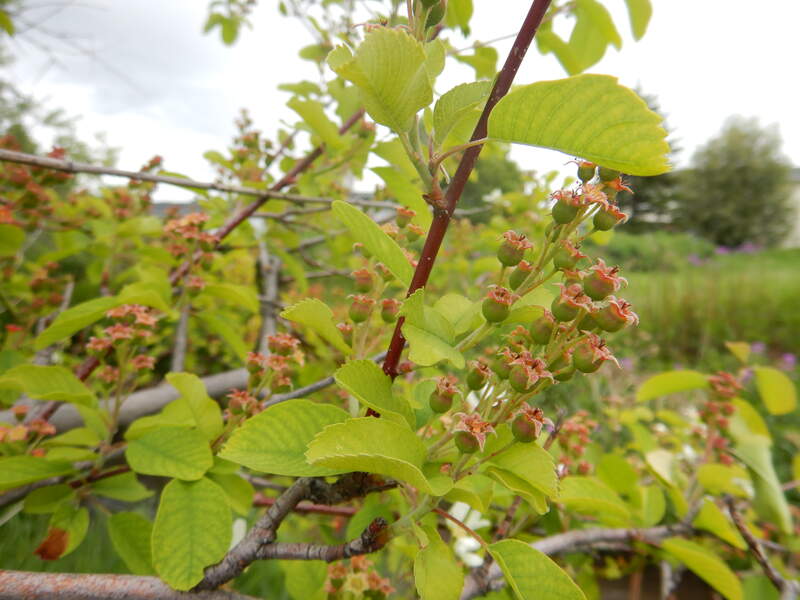
Photo Credit: Matt Lavin / Wikimedia Commons / CC BY-SA 3.0
Find Saskatoon serviceberry growing in subalpine forests, grasslands, woodlands, meadows, plains, and valleys across Montana. This erect, deciduous shrub grows between 4 to 15 feet tall and blooms small clusters of fragrant flowers every spring. This shrub is also known as Juneberry, thanks to small, sweet, blue berries that ripen every summer followed by long-lasting fall foliage that turns shades of orange and red.
Saskatoon serviceberry is important to Montana’s ecosystem. It attracts pollinators, especially native bees, and is a larval host for the California Hairstreak butterfly. Serviceberry is a food source for mammals and birds, including grazers such as sheep, cattle, and goats. Plant this deciduous shrub in borders, woodland gardens, and naturalized areas.
Growth habit: Shrub
USDA hardiness zone: 2-7
Mature size: 4-15 feet tall and wide
Duration: Perennial
Foliage: Deciduous
Sunlight needs: Full sun to partial shade; adapts to full shade
Soil preferences: Adaptable; dry or moist, well-drained soils
Water needs: Drought-tolerant; does not require additional water outside of natural rainfall unless dry weather persists for a week or more
Potential hazards: Non-toxic; edible raw or cooked fruits
17. Snowberry (Symphoricarpos)
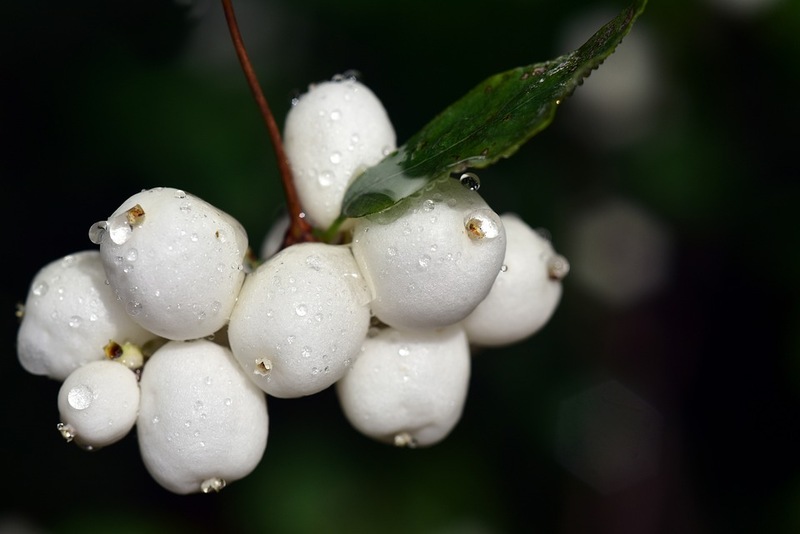
Photo Credit: Pixabay
This small genus of 15 deciduous shrubs goes by many names: snowberry, waxberry, and ghostberry. Montana is home to three native snowberry species growing along its subalpine valleys, plains, and forests. These ornamental shrubs are great for erosion control, naturalized landscapes, and rain gardens. Every fall they put on a show, producing bright white fruits that contrast with their dark green foliage.
Montana’s native snowberry specimens include:
- Common Snowberry (Symphoricarpos albus): This shrub has a bushy, rounded appearance and dull leaves that do not produce fall color. However, the shrub produces green fruits in late summer that ripen to pure white berries in the fall, producing a showy contrast.
- Mountain Snowberry (Symphoricarpos oreophilus): Find this shrub growing across western and southern Montana. This erect shrub produces pink, trumpet-shaped flowers in the spring followed by green berries in the summer that ripen to bright white in the fall, earning the plant its ghostberry nickname.
- Western Snowberry (Symphoricarpos occidentalis): This erect shrub has arching branches, gray-green leaves, inconspicuous pink flowers, and white berries.
Growth habit: Shrub
USDA hardiness zone: 3-7
Mature size: Up to 5 feet tall
Duration: Perennial
Foliage: Deciduous
Sunlight needs: Full sun, partial shade, full shade
Soil preferences: Dry or moist, infertile sand or gravel soils
Water needs: Water one inch per week
Potential hazards: Toxic; mildly poisonous to humans and animals
18. Woods’ Rose (Rosa woodsii)
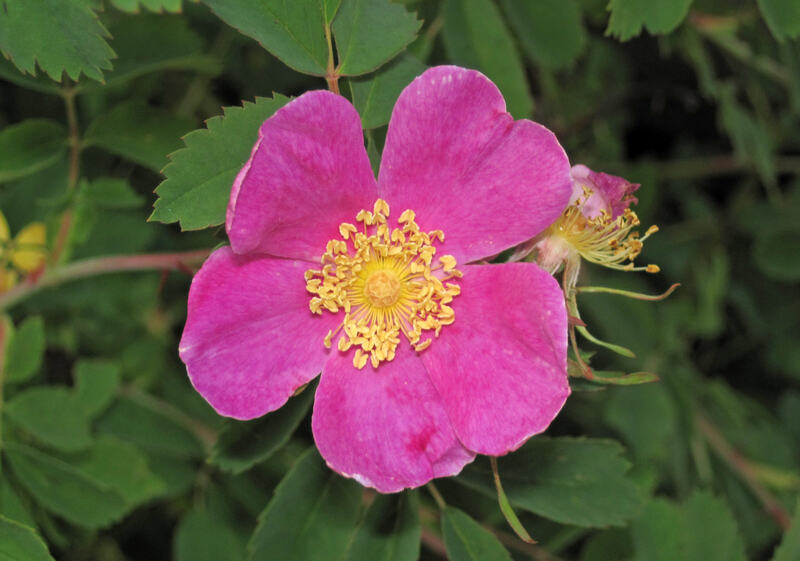
Photo Credit: James St. John / Flickr / CC BY 2.0
Woods’ rose, or western wild rose, is a small, multi-branched deciduous shrub. It loves the dense thickets, snow-catchment areas, woodlands, forests, plains, valleys, and grasslands of Montana. Specimens produce prickled red stems on their lower portions and small, compound leaflets. Woods’ rose blooms large, pink, five-petaled flowers with bright yellow stamens every summer.
This small deciduous, woodland shrub makes a great addition to pollinator gardens. It is especially important to the conservation of native bee species, providing food and nesting materials.
Growth habit: Shrub
USDA hardiness zone: 3-8
Mature size: Up to 15 feet tall; usually shorter
Duration: Perennial
Foliage: Deciduous
Sunlight needs: Full sun, partial shade, full shade
Soil preferences: Dry or moist, sand or light clay soils
Water needs: Drought-tolerant; water one inch per week
Potential hazards: Non-toxic; edible
19. Yarrow (Achillea millefolium)
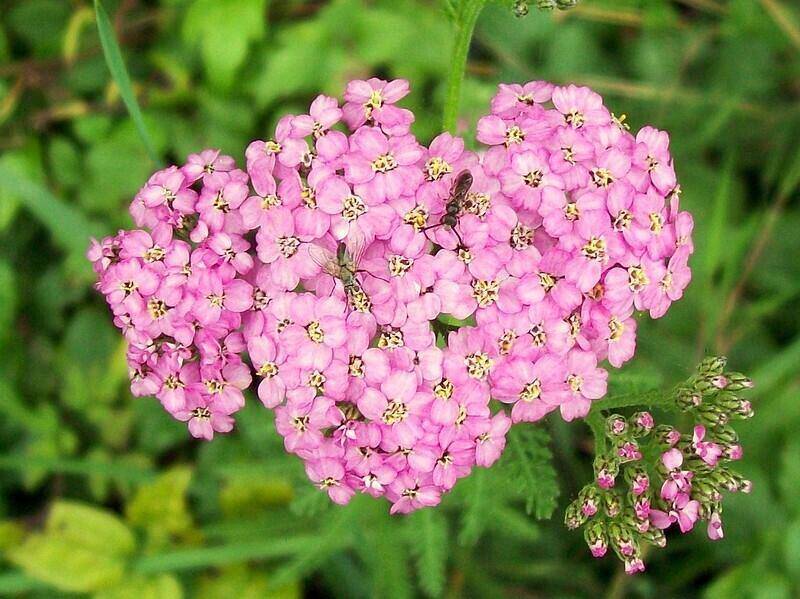
Photo Credit: Peter O’Connor aka anemoneprojectors / Flickr / CC BY-SA 2.0
Yarrow, or common yarrow, grows across Montana in open forests, grasslands, meadows, and fellfields at all elevations. It has a mounding growth habit with long stems reaching up to 3 feet high. Yarrow produces lacy green leaves and leaflets, resembling ferns. Small, flat-topped clusters of tiny white flowers bloom from spring through fall.
These long-blooming perennials are great plants for pollinator gardens, beds, boxes, and containers. Cut and dried flowers make great additions to floral arrangements, and their blooms are very fragrant. Yarrow is an important pollinator plant for local bees.
Growth habit: Herb
USDA hardiness zone: 3-9
Mature size: Up to 3 feet tall
Duration: Perennial
Foliage: Deciduous to semi-evergreen
Sunlight needs: Full sun, partial shade
Soil preferences: Adaptable; dry soils
Water needs: Drought-tolerant; water 1 inch per week
Potential hazards: Toxic; poisonous to dogs, cats, and horses
20. Yellow Columbine (Aquilegia flavescens)
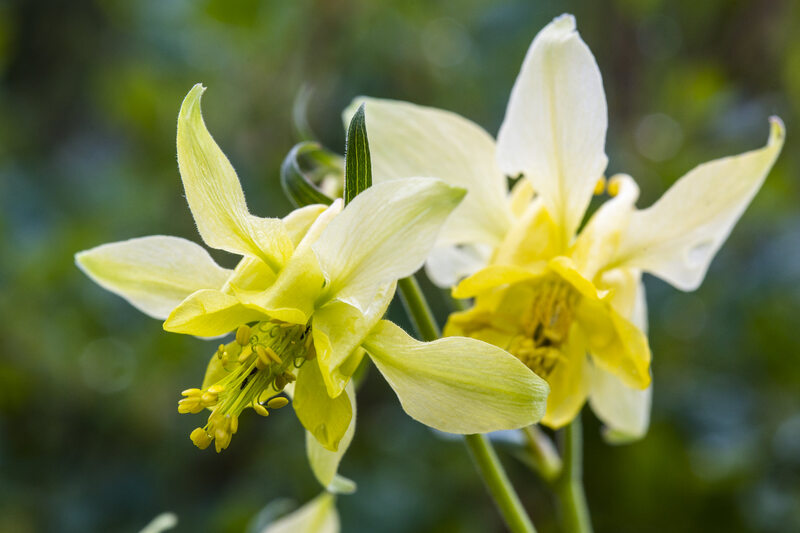
Photo Credit: GlacierNPS / Flickr / Public Domain
Yellow columbine is a perennial herb and a member of the buttercup family. This Montana native grows up to 3 feet tall with showy, tuberous yellow and pale peach blooms that droop, exposing bright yellow stamens. Find this herbaceous flower growing across western Montana in the moist soils of meadows, open forests, stream banks, and rocky slopes.
Yellow columbine has an erect growth pattern and bright green leaves. Its flowering tubes attract hummingbirds and butterflies and rabbits love to munch on its foliage. This perennial prefers partial shade. Yellow columbine struggles when other plants compete with its root systems and prefer to grow alone as a groundcover in flower beds, at the edges of gardens, or in containers.
Growth habit: Herbaceous flower
USDA hardiness zone: 3-8
Mature size: Up to 30 inches tall
Duration: Perennial
Foliage: Semi-evergreen
Sunlight needs: Partial shade
Soil preferences: Prefers moist, rocky soils
Water needs: Drought-tolerant; water 1 inch per week
Potential hazards: Toxic; poisonous mature seeds and roots
How to Choose Native Plants for Your Montana Yard
Native plants have specific needs depending on the type and species you select. Your yard has its own unique microclimate, and not all native plants will grow well in your landscape. Select plants suitable for the sun exposure, soil, and water capabilities of your landscape.
Montana sits in USDA Hardiness Zones 3a to 6a, indicating the coldest annual temperature is -40 to -35 degrees Fahrenheit in the alpine regions of the state. The majority of the Treasure State falls within zones 3b to 4a. Montana native plants are cold-hardy to the minimum temperature in the hardiness zones. Keep your zone in mind when selecting non-native plants for your landscape.
FAQ About Native Montana Plants
Plant flowers and deciduous plants in May when nighttime temperatures remain above freezing. Sow evergreen plants, shrubs, and trees in early fall.
Montana is one of 20 states with state soil. Its state soil is Scobey soil, a deep, well-draining, clay loam. Scobey soil is a fertile, dark, farming soil developed from a glacial till, the rich sediment deposited by a glacier.
The best way to identify your landscape’s soil type is to send a soil sample in for testing to your local Montana State University extension testing laboratory.
Early morning is the best time to water your native plants. Winds are calmer and temperatures are lower, so there is less risk of water loss from evaporation or scorching from the sun. Additionally, foliage needs time to dry before nightfall. Wet foliage can lead to disease and rot.
Where to Find Native Plants in Montana
Chances are good you already have native plants in your yard or around your neighborhood. If you want to introduce more plants into your Montana landscape, be sure to source your plants ethically and never transplant them from the wild. The Montana Native Plant Society is a great resource to help determine if a plant is suitable for your landscape.
Filling your yard with native plants is only one step in your landscaping design project. Round out the planning process with our Montana landscaping guides:
- Best Grass Types for Montana
- Drought-Resistant Landscaping Ideas
- Fire-Resistant Landscaping Ideas
No matter where you are in the Treasure State, you can turn over your lawn upkeep to a professional. Let Wikilawn connect you with a local landscaping pro in your area so you can spend more time soaking up Big Sky Country’s rugged beauty.
Main Image Credit: AnemoneProjectors / Wikimedia Commons / CC BY-SA 2.0